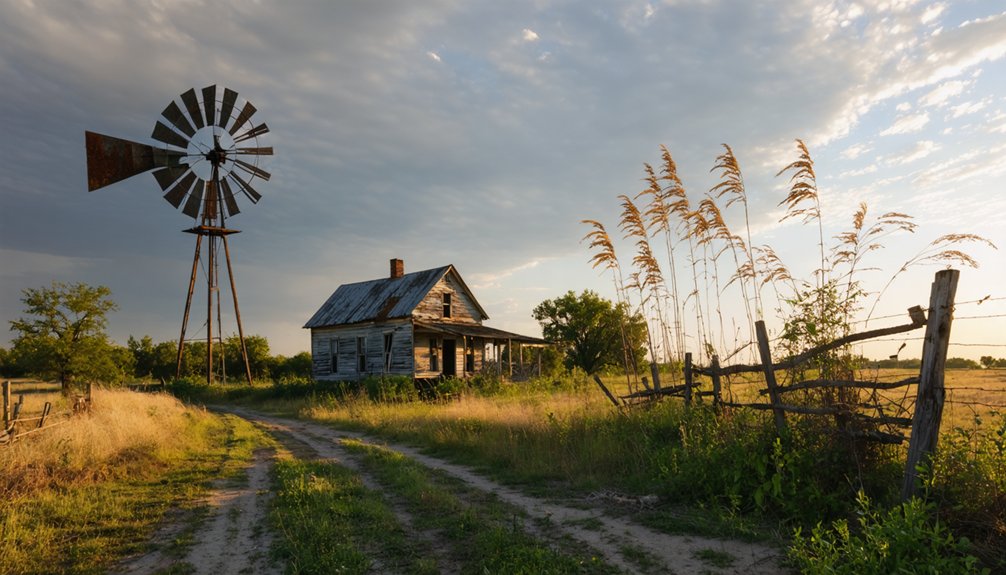You’ll find Boldtville, Texas just 9 miles southeast of downtown San Antonio, where it stands as a monument to Bexar County’s agricultural heritage. Originally established as Wright in 1860, the town transformed into Calaveras before becoming Boldtville in 1919 after Albert F. Boldt’s land donation. The historic schoolhouse, now a Texas Historic Landmark, anchors this ghost town’s remains. While most residents departed during mid-20th century economic shifts, Boldtville’s story of boom and decline captures a fascinating chapter of Texas history.
Key Takeaways
- Boldtville, Texas began as Wright in 1860, reached its peak population of 250 in 1892, and later declined into a ghost town.
- Located 9 miles southeast of San Antonio via US Highway 87, Boldtville features remnants of its agricultural and mining past.
- The historic Boldtville Schoolhouse, built in 1919, now serves as the East Central Schools Museum with over 1,000 artifacts.
- Economic decline occurred due to bypassed transportation routes, oil industry dependence, and mass exodus to urban centers.
- Visitors must follow marked paths, respect preservation guidelines, and exercise caution around unstable historic structures.
From Calaveras to Boldtville: A Town’s Evolution
As the small community of Wright took shape in Bexar County around 1860, it marked the beginning of what would eventually become Boldtville, Texas.
Between 1882 and 1885, the town’s name changed to Calaveras, and by 1892, you’d find a thriving settlement of 250 people with hotels, brickyards, stores, and other businesses serving the local farming and ranching population. Like the California town that inspired its name, the community experienced significant growth as mining operations expanded in the region.
The area’s transformation into Boldtville began in 1919 when Albert F. Boldt donated land for a new school east of San Antonio.
In 1919, Albert F. Boldt’s generous land donation for a schoolhouse marked the birth of Boldtville, transforming the local landscape.
This educational impact proved pivotal, as the Boldt family further strengthened community identity by providing land for the Boldtville Presbyterian Church.
The area’s evolution from Wright to Calaveras and finally to Boldtville reflected the changing needs of this close-knit rural Texas community. The area was home to a diverse mix of German and Czech settlers who established successful farms and ranches throughout the region.
The Legacy of Albert F. Boldt
The name Boldtville stands as a tribute to Albert F. Boldt, a blacksmith who transformed this rural Bexar County community through his generous land donations in 1919.
You’ll find his most significant contribution in the schoolhouse he made possible by donating an acre of land along Sulphur Springs Road, originally part of the Augustin St. Martin Spanish land grant.
The Boldt family’s influence extended beyond education. They helped establish essential community infrastructure, including a church, and worked alongside trustees Joseph Halbardier, Sr. and Robert Uecker to assess local needs. Local resident Fritz Gembler completed construction of the schoolhouse that same year.
Today, curious genealogists can explore Boldtville’s history through free resources on FamilySearch.org to discover more about its early settlers.
Born in Shavano in 1879, Albert lived until 1961, leaving an enduring legacy that’s still visible in historical markers and local histories.
His vision for Boldtville created a foundation for education and community development that defined this slice of East Central Texas.
Life in Early Boldtville
Life in early Boldtville painted a picture of classic rural Texas, where you’d find families like the Averys, Barnhills, and Ueckers working together to build a thriving agricultural community east of San Antonio.
You’d start your day walking dusty roads to the two-room schoolhouse or tending to farm work, with daily routines centered around the land and local commerce. Like Austin County’s first colonists, settlers received land title grants for establishing homesteads.
The Avery Store served as the heart of social life, where you could grab supplies or share news with neighbors.
Community gatherings often featured baseball and volleyball games, while children played in the schoolyard during recess.
Without modern utilities, you’d carry water from nearby sources and rely on outhouses for sanitation. Much like the early Villa de Bexar settlers, residents had to be resourceful with limited infrastructure.
Despite these simple conditions, the spirit of mutual support among settler families created a resilient, self-sustaining community.
The Historic Boldtville Schoolhouse
Standing proudly at the intersection of Sulphur Springs and Foster Roads, Boldtville’s two-room schoolhouse became a cornerstone of local education in 1919 when Albert F. Boldt, a local blacksmith, donated the land.
Fritz Gembler constructed the wood-framed building, which featured distinctive schoolhouse architecture including a pedimented porch and cupola.
The skilled craftsmanship of Fritz Gembler brought to life a charming schoolhouse, complete with elegant architectural details defining its era.
You’ll find this piece of educational history served grades one through eight until 1960, initially as part of Bexar County Common School District #20.
The schoolhouse earned recognition as a Texas Historic Landmark in 1984.
The facility was first built after school trustees visited newer educational buildings in 1919 and determined a new structure was needed.
As the community grew, a third room was added to accommodate more students.
Today, the building houses the East Central Schools Museum, which opened in 1986.
The museum’s collection includes over 1,000 artifacts that tell the story of rural Texas education, from antique desks to teacher registers, preserving Boldtville’s legacy for future generations.
The Path to Abandonment
As Boldtville’s industries waned in the mid-20th century, you’d have witnessed the town’s slow transformation from a bustling agricultural community into a place of diminishing opportunities.
You’d have seen young families move to larger cities while local businesses shuttered their doors, creating a cycle of economic decline that proved impossible to reverse.
The rerouting of major transportation routes around Boldtville dealt the final blow, leaving the once-vibrant town increasingly isolated from the region’s commercial activity. Much like nearby Gussettville when the railroad bypassed it, Boldtville’s fate was sealed. Like the town of Plemons, which became largely abandoned and private property, Boldtville’s accessibility gradually disappeared.
Economic Challenges Mount
While Boldtville once thrived on its oil and gas operations, the town’s singular economic focus ultimately spelled its downfall.
As oil prices plummeted and drilling activity slowed, you’d witness the rapid economic decline sweep through the community. Home values plunged by up to 47%, while properties sat unsold for months.
The lack of community resilience became painfully apparent as foreclosures surged 40% year-over-year. Without jobs outside the energy sector, working-age residents fled, leaving behind empty homes and struggling businesses.
You’d find rental vacancies exceeding 20%, forcing landlords to slash rates. Development projects froze mid-construction, and public spaces deteriorated as municipal budgets dwindled.
The town’s failure to diversify beyond oil and gas left it defenseless against market fluctuations, sealing its fate.
Rural Population Drifts Away
The economic collapse triggered a mass exodus from Boldtville that would prove irreversible.
You’ll find this rural migration pattern mirrored across west Texas, where declining birth rates and aging populations have hollowed out countless communities since the 1970s. The town’s workforce vanished as young adults sought opportunities in urban centers, leaving behind an increasingly elderly population.
Without new families moving in, Boldtville’s population decline accelerated through a vicious cycle.
You’d see fewer children in the schools each year until they finally closed, while essential services disappeared one by one. The isolation from major cities meant there wasn’t enough draw to attract new residents.
What you’re left with today is a community that’s aged out, where deaths outnumber births, and the remaining social fabric has largely unraveled.
Ghost Town Tourism and Exploration
When you’re exploring Boldtville’s historic sites, you’ll need to stay on marked paths and follow posted warning signs for your safety.
You can access the town’s main structures through designated walking routes that protect both visitors and the fragile remains of this Texas ghost town.
Keep a safe distance from unstable buildings, bring plenty of water, and notify local authorities of your visit, as the remote location requires extra precautions.
Located just 9 miles southeast of downtown San Antonio, Boldtville offers ghost town explorers relatively straightforward access via US Highway 87, making it an accessible destination for urban adventurers.
When planning your visit, you’ll want to utilize GPS-based tools and interactive maps to pinpoint exact locations, as ghost town navigation can be challenging due to limited signage and unpaved roads.
Understanding the town’s position within Bexar County and its relationship to historical railroad routes will help you better navigate the area.
While specific historical landmarks in Boldtville aren’t well-documented, you can expect to encounter typical ghost town features like abandoned structures and architectural remnants.
Remember that Texas ghost towns range from completely deserted sites to partially inhabited communities, so respect any current residents during your exploration.
Preservation and Safety Guidelines
Safe exploration of Boldtville requires careful adherence to preservation guidelines and safety protocols.
You’ll need to stay on established paths and avoid disturbing any structures or artifacts, as federal and state laws protect these historic sites. Don’t collect souvenirs or use buildings as anchoring points for recovery equipment, as this can damage the site’s integrity.
Before visiting, equip yourself with proper safety gear and self-recovery equipment.
You’re responsible for bringing communication devices, first aid supplies, and ensuring someone knows your travel plans. If you’re unsure about navigation or site conditions, consider joining a guided tour.
Remember that abandoned structures can be unstable, and environmental hazards may be present.
Preserving Boldtville’s Heritage

Through dedicated preservation efforts, Boldtville’s heritage remains alive thanks to local historical societies and community groups working to protect its physical structures and cultural legacy.
You’ll find ongoing community engagement through heritage festivals, educational tours, and volunteer cleanup projects, though funding challenges often limit large-scale restoration work. Local residents and descendants contribute valuable oral histories and artifacts to enrich the town’s historical record.
- Historical societies digitize maps, deeds, and correspondence for research accessibility
- Protected structures undergo regular monitoring for structural integrity
- Cemetery preservation includes fencing and group headstones for unmarked burials
- Educational programs introduce local youth to ghost town history
- Partnerships between county governments and historical associations provide vital support
Frequently Asked Questions
Are There Any Reported Ghost Sightings or Paranormal Activity in Boldtville?
You won’t find documented ghost stories or paranormal investigations in Boldtville. While surrounding Texas areas have reported hauntings, current research shows no credible evidence of supernatural activity in this location.
What Is the Estimated Current Population of Boldtville Today?
You’ll find a population of roughly 1,250-1,300 people today, based on the 2020 census count of 1,241 and modest regional growth patterns within the Greater San Antonio metropolitan area’s expanding demographics.
Can Visitors Legally Explore Private Properties Within Boldtville’s Boundaries?
You can’t legally explore private properties without explicit owner permission. Property access is restricted by Texas law, and you’ll face legal consequences for trespassing on these lands without consent.
Which Original Boldtville Buildings Are Still Standing Besides the Schoolhouse?
Clear as day, you’ll find the original church, several early settler homes, a few general stores, meeting halls, and ranch outbuildings – all holding historical preservation value and architectural significance.
Are There Any Annual Events or Festivals Celebrating Boldtville’s History?
Currently there aren’t any annual events specifically celebrating Boldtville’s history. While nearby communities host local traditions and history tours, none focus exclusively on preserving or commemorating Boldtville’s unique heritage.
References
- https://www.youtube.com/watch?v=j1vcl01ulo8
- https://txprobatelawyer.net/the-rise-of-ghost-towns-can-you-own-a-piece-of-abandoned-texas/
- https://www.ksat.com/holidays/2018/10/30/texas-has-more-ghost-towns-than-any-other-state/
- https://en.wikipedia.org/wiki/List_of_ghost_towns_in_Texas
- https://pastmaps.com/explore/us/texas/bexar-county/san-antonio/boldtville/hiking-exploration
- https://www.hmdb.org/m.asp?m=205699
- https://www.tshaonline.org/handbook/entries/boldtville-tx
- https://en.wikipedia.org/wiki/Boldtville
- http://pacweb.alamo.edu/interactivehistory/projects/rhines/studentprojects/2006/boldtvolle/Boldtville.html
- https://www.texasescapes.com/SouthTexasTowns/Caddo-Texas.htm



